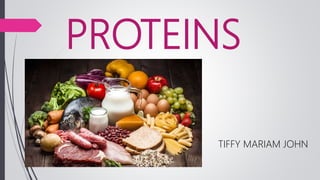
Proteins , INTRODUCTION, GOOD PROTEINS, BAD PROTEINS, STRUCTURE OF PROTEINS, PRIMARY, SECONDARY, TERTIARY AND QUATERNARY STRUCTURE, FIBROUS AND GLOBULAR STRUCTURE, SOURCES, TYPES OF PROTEINS, FUNCTIONS,DEFICIENCIES
- 2. Proteins are very large organic compounds. Proteins, like carbohydrates and fats, contain carbon, hydrogen and oxygen. In addition, proteins contain about 16 per cent nitrogen, which is their unique feature and distinguishes them from carbohydrates and fats. Some proteins also contain sulphur and sometimes phosphorus, iron and cobalt. Proteins are more complex than fats and carbohydrates, as the size of the molecule is large and there is a great variation in the units from which it is formed. INTRODUCTION
- 3. Next to water, protein is the most abundant component of the body. It accounts for about a sixth of the live body weight a third of it is found in the muscles, a fifth in the bones and cartilage, a tenth in the skin the remainder in other tissues and body fluids. There are thousands of different specific proteins in the body, each having a unique structure and function. For this reason, the word protein implies not one but a large group of complex compounds. Proteins are present in all living tissues, both plant and animal. They are essential to life because vital parts of the nucleus and protoplasts of every cell are proteins.
- 4. Plants are the primary source of proteins in nature. Proteins are synthesised by the plants from the nitrates and ammonia in the soil. Herbivorous animals use plant proteins to meet their protein needs. Man uses plant foods as also animal foods (milk and meat) to meet his protein needs. Nitrogen is returned to the soil through degradation of products of animal metabolism, excretion of nitrogen compounds in urine and faeces, and decomposition of animal body at death, to complete the natural nitrogen cycle.
- 5. STRUCTURE OF PROTEIN All proteins in our body and food are built from basic units or compounds known as amino acids. Amino acids combine to form proteins by means of a peptide bond Polypeptiddes thus formed constitute the primary structure of proteins. The secondary structure formed by linking several polypeptide chains may be helical, pleated or random coil. More complex proteins have a tertiary structure in whcih the polypeptide chain is wound into a globular form.
- 7. Proteins exist in fibrous or globular form. Fibrous proteins appear in structure elements, e.g., collagen of connective tissue, myosin of muscle tissue and keration of hair. Globular proteins are very soluble and occur in tissue fluids; these include casein, egg albumin, albumins and globulins of blood plasma and haemoglobin. In conjugated form, they form most of the intracellular enzymes.
- 9. Simple proteins yield only amino acids on hydrolysis. Albumins, globulins, glutelins, prolamins and albuminoids are simple proteins. Conjugated proteins are combinations of simple proteins with non-protein substances. The combinations result in formations, which are functionally very important to the body. Conjugated proteins include: • Lipoproteins (proteins + lipids) found in blood plasma (HDL, LDL, VLDL, etc.). • Nucleoproteins (proteins + nucleic acids) found in cells (RNA, DNA). •Mucoproteins and glycoproteins (proteins + polysaccharides) found in gastric secretion (mucin). • Phosphoproteins (proteins + phosphoric acid) are found in milk, e.g., casein. • Metalloproteins (proteins + metals) are found in ferritin, hemosidirin. Derived proteins are proteoses, peptones and peptides formed in the various stages of protein metabolism.
- 10. FUNCTIONS The primary function of proteins is tissue building. Proteins are the main solid matter in the muscles, they are also the major constituents of blood, matrix of bones, teeth, skin, nails and hair. Our body, which consists of about 60 per cent water and 19 per cent fat is held together by only 17 per cent proteins and 4 per cent minerals.
- 11. The principal functions of proteins in the body are discussed below. Body-Building or Building of New Tissues: Maintenance of tissues Regulatory Functions: Proteins as Precursors of Enzymes, Hormones and Antibodies: Transport of Nutrients Milk Formation Energy Supply
- 13. DEFICIENCIES Children tend to have retarded growth but this may not be noticed Protein deficiency during pregnancy may result in stress, Severe Deficiency: If there is severe deficiency of protein in the first two years of life, it could affect mental development, learning ability and behaviour. In India and other tropical developing countries, protein-energy malnutrition (PEM) is a common disorder during childhood. When the child is weaned, the diet often does not contain an adequate quantity and quality of protein which results in deficiency diseases.
- 14. When an infant is fed high carbohydrate low protein foods such as ragi (corn starch porridge), kwashiorkor, a typical protein deficiency condition occurs. When both protein and calorie are very low in the diet, nutritional marasmus could occur. In other words, kwashiorkor is a deficiency disease due to severe lack of protein but nutritional marasmus is due to sheer starvation. The education of prospective parents about childcare and nutrition can ensure good nutrition of infants and young children and prevent protein-calorie malnutrition. Greater attention is needed to appropriate supplementary nutrition for children in the 0–2 age group, the most critical period in terms of brain and body growth.